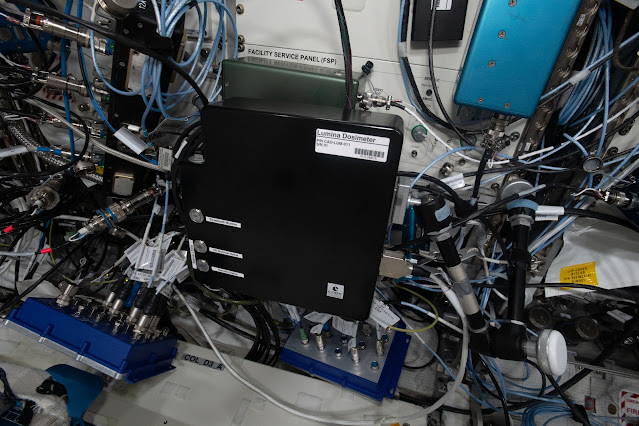ISS - Expedition 67 Mission patch.
April 22, 2022
Crew members aboard the International Space Station conducted scientific investigations during the week of April 18 that included studying a new method for preserving biological materials, testing a technology for measuring radiation dose, and observing changes in muscle tone during spaceflight. The four-member crew of Axiom Space Mission 1 (Ax-1) is scheduled to depart the station on Saturday, April 23.
Image above: The SpaceX Dragon Endurance, shown here docked to the forward-facing port of the station’s Harmony module, carried four Crew-3 astronauts to the orbiting lab. Image Credit: NASA.
The space station, continuously inhabited by humans for 21 years, has supported many scientific breakthroughs. A robust microgravity laboratory with dozens of research facilities and tools, the station supports investigations spanning every major scientific discipline, conveying benefits to future space exploration and advancing basic and applied research on Earth. The orbiting lab also provides a platform for a growing commercial presence in low-Earth orbit that includes research, satellite services, and in-space manufacturing.
Image above: Mount Vesuvius on Italy’s Gulf of Naples is pictured from the International Space Station as it orbits 260 miles above. Image Credit: NASA.
Here are details on some of the microgravity investigations currently taking place:
No freezing required
Rhodium Crystal Preservation studies using crystal formation to preserve biological material for research. Preservation is a necessity for research conducted in remote environments such as space, where immediate access to analytical equipment is limited. But some methods used to preserve biological samples, such as freezing, require special equipment and a power source. These crystal matrices do not require special conditions and could provide a way to maintain biological materials for research on future space missions. A more stable technique for preserving biological materials also has potential applications for research on Earth in remote locations and in areas where the ability to maintain a cold chain is limited. Crew members monitored hardware for the investigation during the week.
Illuminating radiation doses
Image above: This image shows the Lumina dosimeter installed on the space station. This ESA investigation demonstrates using optical fiber technology to monitor the radiation dose received by crew members in real time. Image Credit: NASA.
Lumina, an ESA (European Space Agency) investigation, demonstrates a dosimeter using optical fibers to monitor in real time the radiation dose received by crew members. The fibers darken when exposed to radiation, providing reliable measurements in complex radiation environments, and the device can handle the extreme conditions of space such as temperature variations. Monitoring radiation is a key challenge for future longer-term space exploration, and this technology could make it possible to anticipate and respond to potentially dangerous radiation flares, helping to protect the crew. This technology also has potential applications in the medical and nuclear industries on Earth. During the week, crew members transferred data from the Lumina device via a dedicated app on a tablet.
Managing muscles
ESA’s Myotones investigation observes changes in muscle properties such as tone and stiffness during long-term spaceflight. Muscle tone is important for postural control, awareness of body position, and muscle force, but the biomechanics are not well understood. A better understanding of these fundamental principles could help protect astronauts on future missions as well as support development of new treatments for issues caused by normal aging and restricted mobility on Earth. Crew members collected blood samples and conducted measurements for the investigation during the week.
Image above: The crew aboard the International Space Station has a window on Planet Earth. In this image an orbital sunrise beams across Earth's horizon revealing silhouetted clouds above the South China Sea. Image Credit: NASA.
Other investigations involving the crew:
- Hicari, an investigation from the Japan Aerospace Exploration Agency (JAXA), demonstrates a method to produce high-quality crystals of semiconductor material. The material shows potential for electronic devices that require less energy, and the production method also could support development of more efficient solar cells and semiconductor-based electronics.
https://www.nasa.gov/mission_pages/station/research/experiments/explorer/Investigation.html?#id=71
- Vascular Aging, a Canadian Space Agency (CSA) investigation, collects data on vascular changes in astronauts. Results could support development of ways to reduce potential health risks to crew members as well as guide prevention measures and treatments for the effects of aging on Earth.
https://www.nasa.gov/mission_pages/station/research/experiments/explorer/Investigation.html?#id=7644
- SERFE investigates the effect of contamination and corrosion on a spacesuit thermal control system and microgravity’s effect on the system’s ability to regulate astronaut body temperature under various conditions. The technology could support development of spacesuits for future exploration missions and contribute to improvements in technology using evaporation for cooling on Earth.
https://www.nasa.gov/mission_pages/station/research/experiments/explorer/Investigation.html?#id=7514
- Students across Europe use two augmented Raspberry Pi computers aboard the space station for AstroPi, an education program coordinated by ESA. The program helps motivate students to study science, technology, engineering, and mathematics.
https://www.nasa.gov/mission_pages/station/research/experiments/explorer/Investigation.html?#id=7534
- For ESA’s CalliopEO, German school children write software to run experiments on a Calliope mini-computer aboard the space station. The experience helps motivate students to pursue science, technology, engineering, and mathematics fields and become the next generation of explorers.
https://www.nasa.gov/mission_pages/station/research/experiments/explorer/Investigation.html?#id=8567
- Actiwatch is a wearable monitor that continuously collects data on a crew member’s circadian rhythms, sleep-wake patterns, and activity during flight, beginning as soon as possible after arrival aboard the station.
https://www.nasa.gov/mission_pages/station/research/experiments/explorer/Facility.html?#id=838
- Standard Measures collects a set of core measurements from astronauts before, during, and after long-duration missions to create a data repository to monitor and interpret how humans adapt to living in space.
https://www.nasa.gov/mission_pages/station/research/experiments/explorer/Investigation.html?#id=7711
Space to Ground: Home: 04/22/2022
Related links:
Expedition 67: https://www.nasa.gov/mission_pages/station/expeditions/expedition67/index.html
Axiom Space Mission 1 (Ax-1): https://www.nasa.gov/leo-economy/nasa-enables-first-private-astronaut-mission-to-station
Rhodium Crystal Preservation: https://www.nasa.gov/mission_pages/station/research/experiments/explorer/Investigation.html?#id=8712
Lumina: https://www.nasa.gov/mission_pages/station/research/experiments/explorer/Investigation.html?#id=8444
Myotones: https://www.nasa.gov/mission_pages/station/research/experiments/explorer/Investigation.html?#id=7573
ISS National Lab: https://www.issnationallab.org/
Spot the Station: https://spotthestation.nasa.gov/
Space Station Research and Technology: https://www.nasa.gov/mission_pages/station/research/overview.html
International Space Station (ISS): https://www.nasa.gov/mission_pages/station/main/index.html
Images (mentioned), Video (NASA), Text, Credits: NASA/Ana Guzman/John Love, ISS Research Planning Integration Scientist Expedition 67.
Best regards, Orbiter.ch





